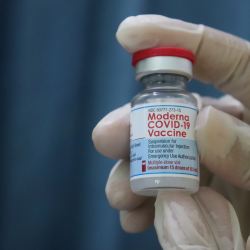In order to prepare for the emergence of new SARS-CoV-2 "variants of concern" or other epidemic coronaviruses, researchers are taking a variety of approaches to creating vaccines that will protect against not only known viruses but also against variants that have not yet appeared.
We have learned a lot about the SARS-CoV-2 virus during the three years of the COVID-19 pandemic. For example, new viral variants, such as the many subtypes of Omicron, are less susceptible to the vaccines developed to protect against the original Wuhan SARS-CoV-2. Moreover, protection from the vaccines wanes substantially with time. For those reasons and because vaccine uptake, especially of boosters, has been anemic in the U.S., we are still experiencing almost 2,000 deaths per week.
Despite a downward trend in both hospitalizations and deaths in the U.S., there are reasons for concern – especially the increasing ability of successive SARS-CoV-2 variants of concern to escape immunity from natural infection or vaccination, and the risk of spillovers of various animal coronaviruses into humans. A 2015 article in Nature Medicine by an international group of researchers described the peril posed by a SARS-like virus, SHC014-CoV, which was then circulating in Chinese horseshoe bat populations, concluding that there was “a potential risk of SARS-CoV re-emergence from viruses currently circulating in bat populations.”
We need, therefore, to be prepared for the emergence of new pandemic viruses – including by developing something akin to a “universal vaccine” that will protect against multiple types of coronaviruses, including newly-arising viral variants. Several approaches are being taken, including modifying adenoviruses as a vector for vaccine antigens and using ferritin nanoparticles and self-amplifying RNA (which works similarly to messenger RNA (mRNA) except that it can replicate itself once inside the body's cells).
To elicit a broader immune response, some vaccine developers are incorporating numerous fragments of the SARS-CoV-2 virus' spike proteins, which bind to human cells and enable the virus to gain access. Other researchers are focusing on parts of the virus that have been highly conserved – that is, don’t tend to mutate – in the variants of concern that have arisen up to now.
Caltech Professor Pamela Bjorkman and her colleagues have used the former approach with some preliminary success. They have presented the immune system – in animal models, to this point – with fragments of the spike proteins from SARS-CoV-2 and seven other SARS-like betacoronaviruses that have been attached to a protein nanoparticle, forming a structure that induces the production of a broad spectrum of cross-reactive antibodies. Early results showed that antibodies elicited by this synthetic vaccine were able to bind not only to the eight coronaviruses represented on the nanoparticle, but to four additional coronaviruses not present in the vaccine.
Another important finding was that “when vaccinated with this so-called mosaic nanoparticle, animal models were protected from an additional coronavirus, SARS-CoV, that was not one of the eight represented on the nanoparticle vaccine” [emphasis in original]. That implies that the vaccine could provide protection against subvariants of SARS-CoV-2 that have not yet appeared.
Thereafter, the group reported that the vaccine appeared to protect mice and monkeys that had been exposed to an array of coronaviruses. Professor Bjorkman hopes to have a vaccine in clinical trials by next year.
A large group of U.S. Army medical researchers is also making important advances with a nanoparticle that elicited neutralizing antibodies against the original (Wuhan) SARS-CoV-2 virus and subsequent variants of concern, as well as against SARS-CoV, the virus that caused the SARS outbreak 20 years ago. More specifically, “potent humoral and cell-mediated immune responses translated into rapid elimination of replicating virus in the upper and lower airways and lung parenchyma of nonhuman primates after high-dose SARS-CoV-2 respiratory challenge.” They already have a vaccine in an early clinical trial.
Substantial amounts of public and private research funding are being made available for ongoing work on such vaccines. The Coalition for Epidemic Preparedness Innovations (CEPI) has provided initial funding of around $200 million, and the NIH has added an additional $36 million. But those expenditures won’t begin to cover the costs of the clinical trials required and fall far short of the approximately $10 billion spent by the Trump Administration on Operation Warp Speed, which was instrumental in developing the first round of COVID vaccines in 2020 in record time. If we are to be prepared for the next coronavirus pandemic, we need far more funding of both basic and applied vaccine research.

